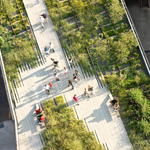Case Study - High Line Park Horticulture
Recycling a NYC elevated railway into a unique park

Standing a mile-and-a-half long on Manhattan’s west side is the elevated railroad known as the High Line. Built for freight deliveries in 1934, the last train ran on the High Line in 1980. From then on, nature took over - quietly, like a secret.
Wind and wildlife dispersed seeds over the abandoned railroad and a lush garden grew amid the ballast and steel tracks. Closed to the public, the trestle’s primary visitors were wild - birds, insects, and the occasional adventurous human. For these explorers, finding one’s self alone in a city of 8 million, 30 feet above street level, with a view of the Hudson River whose winds made the Irises and Evening Primrose sway - was magical. Meanwhile, on the ground, property owners in the surrounding area lobbied to demolish the High Line. But in 2002, a group called Friends of the High Line won the city’s support to preserve the railroad and turn it into a public space. The first section of the park opened in June 2009.
Botany is a force of nature whose quiet yet critical role in our ecosystem is often neglected. Fortunately, this is not the case with the new High Line park. The film High Line Horticulture by Irene Tejaratchi Hess (4:13) features an interview with Patrick Cullina, Vice President of Horticulture at the High Line, to learn more about this unique garden in the sky. When shooting this work, filmmaker Hess says she had her mother in mind – her carefully tended yard, and frequent childhood visits to the Bronx Botanical Garden where she’d take innumerable photos of her family next to the flowers. As an adult, Hess says she appreciates such beauty even more.
(Adapted from the work of Irene Tejaratchi Hess, 2009)

